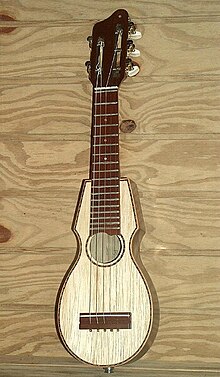Tiple

The tiple (Spanish, from Latin triplum , "triple" related to treble , the highest of three tone ranges) is the name of several plucked box necks in Latin America and the Caribbean . They developed from Spanish guitar-like plucked instruments during the colonial period .
Colombian tiple
The Colombian tiple is built like a slightly reduced guitar with a length of about 90 cm. She has four choirs with three steel strings each . In the three lower choirs, the middle string is wound and tuned an octave lower. The most common tuning corresponds to the four upper strings of the guitar (DGHE). It can be beaten or plucked. The sound is high and brilliant.
In traditional Colombian music, the tiple is combined in various formations with other plucked instruments such as the guitar and mandolin . It is mostly broken through and supports the typical rhythm.
The tiple was created as one of numerous instruments in the guitar family in Latin America based on Spanish models. It has been widespread, especially in Colombia, since the second half of the 19th century and has had its current shape since 1915. In the 1970s she was integrated into larger ensembles by representatives of the Nueva Canción Chilena such as Inti Illimani and Victor Jara , making her known in other countries in South America and beyond. Throughout its history, the style of playing the tiple has become more complex. Today it is also increasingly used electrically.
Tiples from Puerto Rico
In Puerto Rico there are several variants of the tiple, which originated in the rural music of the peasants. In the course of the 20th century their popularity declined in favor of the cuatro and the guitar. It is significantly smaller than the Colombian version and, like the Cuatro, the body is made from one piece of wood.
The most common form is the tiple doliente . It has five strings in the EADCG tuning. Other forms are the tiple requinto with three strings and the tiplon with four equally long and one shortened string (similar to a banjo ).
Spanish tiple
The Spanish or Canarian tiple has five strings, a four-string variant can be found on Tenerife . It is also known as a timple . At approx. 60 cm in length, it is also smaller than the Colombian tiple and is similar in size to a ukulele . The tiple has a long history in Spain. A method for learning the instrument was published as early as 1752.
literature
- Rodrigo Torres: Tiple . In: John Shepherd (Ed.): Continuum Encyclopedia of Popular Music of the World. Vol II Performance and Production . Continuum 2003.
Web links
- Tiple . ( Memento from January 3, 2013 in the Internet Archive ) taquikuna.de (Legend for voting the tiple)
